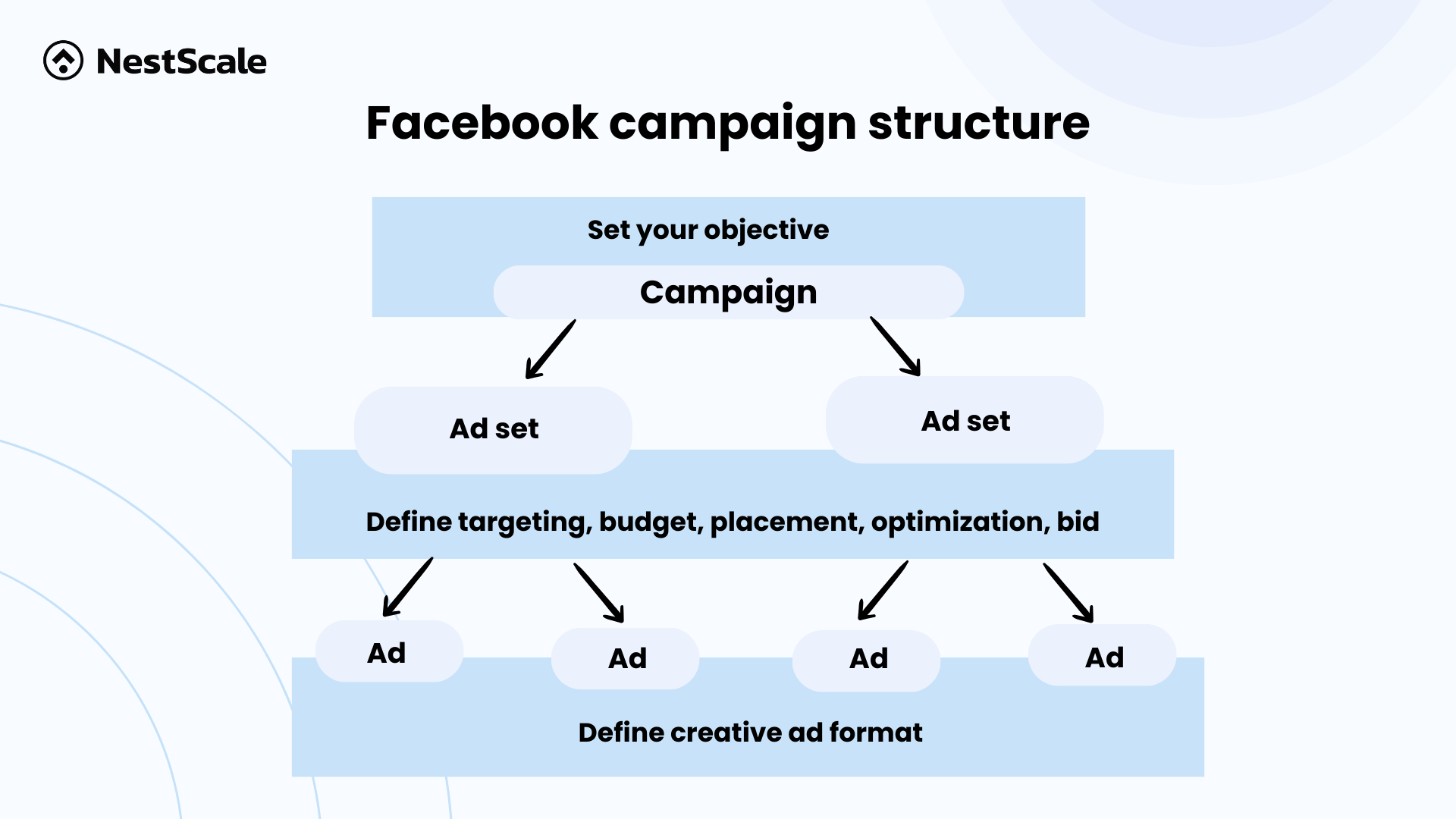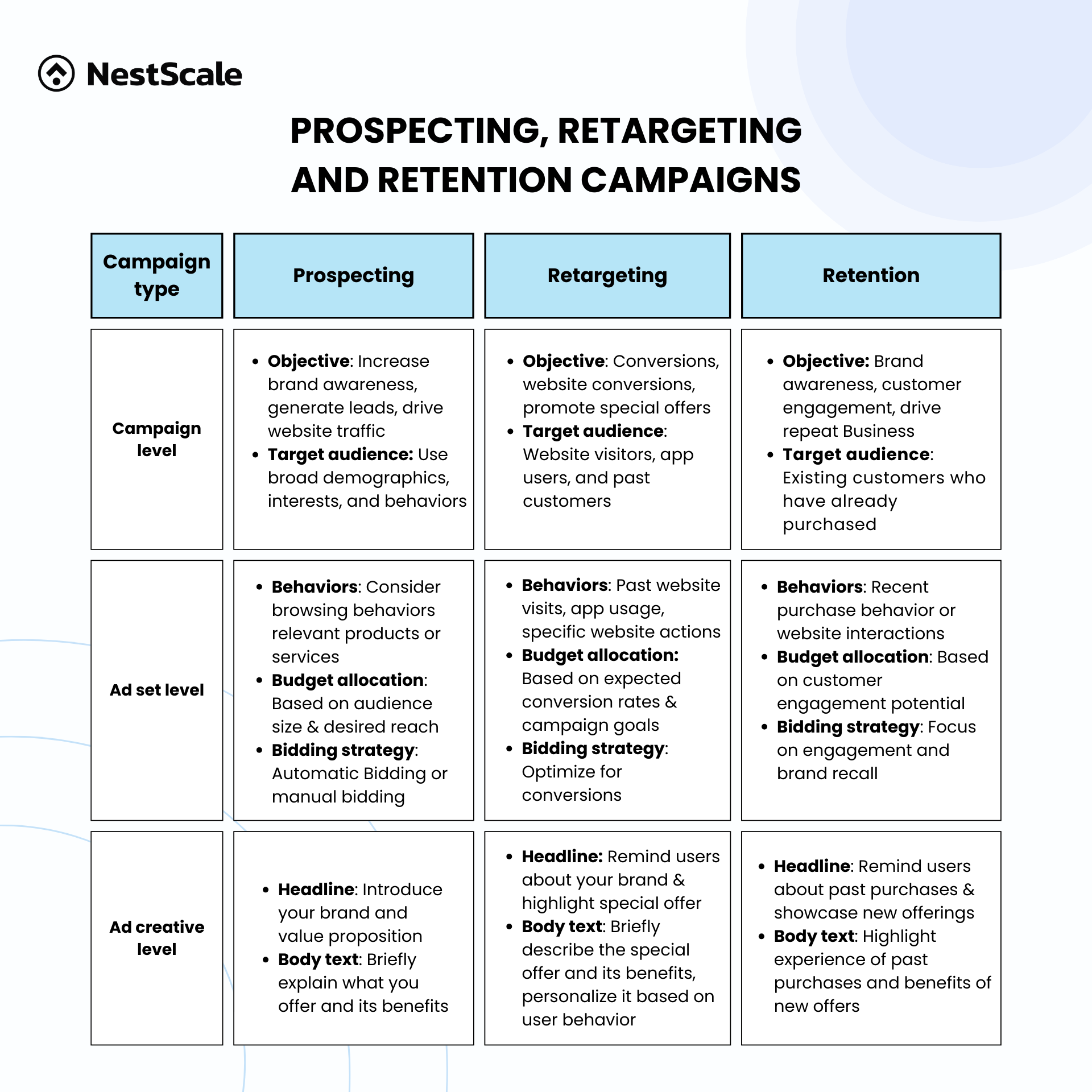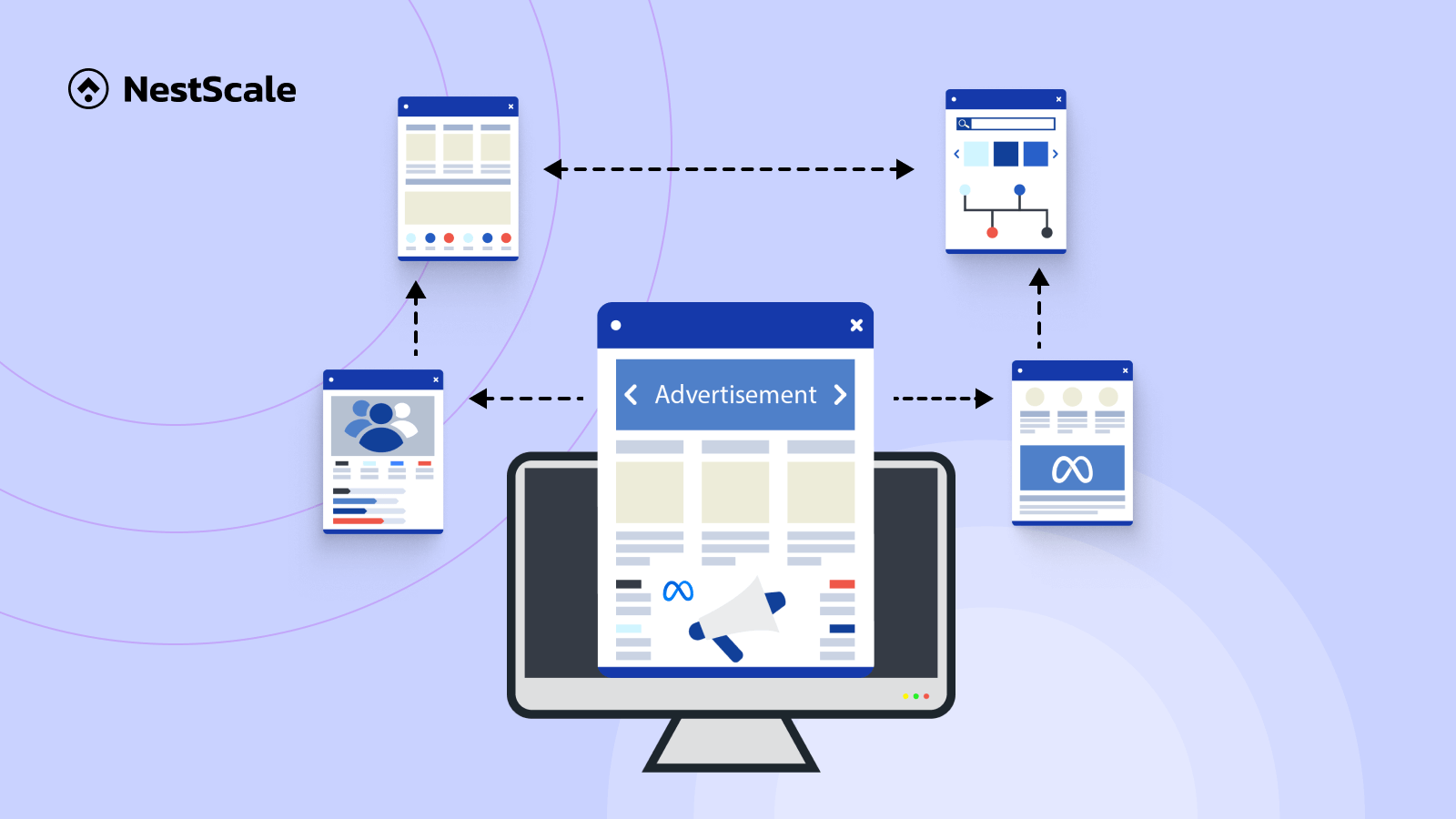Facebook serves as a rich platform for business expansion, and utilizing ads is an effective means to maximize advantages. Nonetheless, crafting an appropriate campaign structure may pose challenges. Don’t worry, we’re here to offer assistance. Let’s explore the Facebook ads campaign structure and what you can do to best utilize its power!
About Facebook ads campaign structure
Before we proceed with detailed information about Facebook ad campaigns, it’s essential to grasp the concept of Facebook advertising. So, let’s start by gaining an understanding of what Facebook ads entail.
What is a Facebook ads campaign structure?
The structure of a Facebook ads campaign encompasses three components: the Facebook campaign, Facebook ad sets, and individual Facebook ads. These elements work together to target the right audience and ultimately enhance sales effectively.
Components of a Facebook ads campaign structure
As we listed before, there will be 3 elements of Facebook ad campaigns. In the next part, we will provide you with detailed information about them.

Ad campaign
A Facebook ad campaign comprises multiple ad sets aimed at achieving a specific campaign objective. While many marketers often opt for the conversion objective, the objective choice can vary based on individual business needs. It’s essential to select a target audience and other campaign parameters accordingly.
Depending on your budget and business goals, establishing multiple ad campaigns can be advantageous, as long as there is no overlap in target audiences. Success in this strategy hinges on crafting a well-structured campaign layout.
If one campaign aims to direct traffic to a blog while another aims for conversions through a landing page, the structure might appear as follows:
- Campaign 1 – Blog: Objective – Link clicks
- Campaign 2 – Conversions: Objective – Optimize for Conversions
Below is the comparison between these two campaigns in many aspects
| Aspect | Short-term blog traffic campaign | Long-term conversion campaign |
| Nature of promotion | Short-term, cyclical, or frequently changed (e.g., different blog posts) | Long-term or evergreen promotions |
| Campaign name | Relevant to the overall goal (e.g., Blog Traffic) | Separate campaigns for each individual promotion |
| Optimization xtrategy | Multiple competing ad sets displaying the same mix of promotions; Facebook optimizes for best-performing promotions | Separate campaigns for each promotion; cycle ad sets and gauge long-term CPAs and conversion rates |
| Optimization strategy | Variability in exposure within each ad set | Show the same audience different variations of the same ad |
| Ad set variation | Complete strategic control over budget allocation | Budget allocation per individual promotion |
Ad sets
To ensure optimal performance in Facebook ad campaigns, it’s crucial to organize ad sets meticulously at the ad set level. This facilitates a deeper understanding of audience performance and allows for strategic budget allocation, prioritizing resources toward effective audiences while avoiding overlap.
Cycling ad sets through various campaigns aid in assessing performance and identifying cost-effective options. Hence, you can break down ad sets by targeting methods for clear performance evaluation as suggested
- Remarketing: Website users
- Lookalike audiences: Based on website users, custom lists, or page likes
- Manually targeted audiences: Interests and behaviors (broad and narrow variations)
- Conversions: Lookalike audiences based on conversions
Or else, you can consider further breakdown options like:
- Geographic location
- Language
- Placement (e.g., Instagram, desktop, mobile)
Ad creative
Now we come to the core of the ad campaign—the ad creative. This is where you decide on the imagery, video, GIF, call-to-action (CTA), and text for your ad content.
As previously mentioned, you can choose from various content formats to structure your ad content. The key is to determine which creative option effectively represents your brand identity and conveys your message.
To eliminate any ambiguity, utilize A/B testing to evaluate various ad types and content variations, enabling you to identify which resonates best with your audience. Leveraging Facebook’s split testing feature can streamline this process. Additionally, drawing inspiration from successful ad creatives can provide valuable insights.
Strategies for structuring your Facebook ad campaign
Now that we’ve outlined the elements of a Facebook ad campaign structure, let’s proceed to the next phase where we’ll assist you in creating a top-notch Facebook ad campaign structure. We’ll provide you with strategies to ensure your campaign is effective and optimized for success.
Structured by types of campaign
When creating an ad campaign, we need to have prospecting, retargeting, and retention campaigns to maximize the benefits the ad campaign could bring about.
First, we need to understand how prospecting, retargeting, and retention campaign
| Campaign type | Means |
| Prospecting campaign | Goal: Reach new audiences who haven’t interacted with your brand before. |
| Retargeting campaign | Goal: Re-engage website visitors, app users, or past customers who haven’t converted yet. |
| Retention campaign | Goal: Engage existing customers and encourage repeat business. |
When choosing each type of campaign, here is what you can set up for each type of campaign. Let’s check it out:

Improve your ad creative
Your Facebook ad creative is the smallest part of your campaign but plays a really crucial role. It’s the first thing people see when they come across your campaign, so it needs to be captivating. Making your ad creative and interesting increases the likelihood of people clicking on it.
There are many ways to make your ad creative stand out, or you can also find inspiration from successful examples:
- Incorporate compelling CTAs tailored to prompt user engagement.
- Utilize high-quality images and videos for maximum impact.
- Prefer to custom visuals over stock photos for authenticity and uniqueness.
- Leverage color psychology to evoke desired emotions in your audience.
- Optimize ad design to ensure compatibility across all devices for a seamless user experience.

Test and utilize beneficial campaign
One effective strategy for utilizing beneficial campaigns is to run experimental campaigns alongside evergreen ones (an evergreen campaign is a marketing strategy designed to provide ongoing value and relevance, remaining effective over an extended period). By doing so, you can continuously test new approaches and identify top-performing ads over time.
As you discover successful ads in your experimental campaigns, transfer them to your evergreen campaigns for ongoing use. This iterative process fosters creative learning and enables incremental improvements in metrics like click-through rate (CTR), cost per action (CPA), and return on ad spend (ROAS).
For prospecting campaigns, it’s advisable to focus on those that generate at least 30 conversions per week. This threshold ensures the campaign’s effectiveness, although surpassing this benchmark is even better. You can reference our suggestion for your campaign
| Campaign type | Budget allocation |
| Prospecting, evergreen | 60% |
| Prospecting, experimental | 20% |
| Retargeting | 15% |
| Retention | 5% |
Tips to optimize your Facebook ads campaign structure
Having equipped you with strategies for crafting your Facebook campaign, let’s delve into the best practices to ensure a winning campaign structure.
Don’t utilize multiple campaigns
Facebook allows users to run multiple campaigns simultaneously, but it’s important not to abuse this capability. Running numerous campaigns for a single product concurrently can result in audience overlap, leading to decreased engagement and low relevance scores. In essence, regardless of the amount spent, the outcome may be minimal.
For a single product, it’s advisable to concentrate on one or two well-optimized campaigns to achieve optimal results. Testing various conversion events can help determine which yields the best outcomes, allowing you to prioritize and focus on utilizing them effectively.
Stop setting up new campaigns and ad sets every time
Facebook requires time to assess your campaign and assign a relevance score. Consequently, setting up numerous campaigns can prolong the evaluation process, potentially resulting in unnecessary expenditure of time and budget. For this point, you can help Facebook understand your campaign by making any adjustments needed without ending it. By doing so, your ad will sooner hit the target and engagement bar.
Set naming convention
There are no restrictions imposed by Facebook on ad naming, allowing you to take advantage of this feature to create unique names. To organize your ad sets effectively, it’s helpful to incorporate macros or hyphens into their names. By using specific and descriptive names for your ad sets, you’ll find it easier to manage and organize them.
We recommend creating a naming template for your campaigns, ad sets, and ads. This approach establishes a consistent format for your ads, simplifying future monitoring and management.

Handle customer overlaps
When running many ads, overlaps tend to happen. It arises when a user is included in multiple audiences, resulting in increased cost-per-click as your ads compete against each other. Small overlaps are easier to handle. However, when overlap grows significantly, you can take these steps to address:
- Refining: Make audiences more specific to reduce overlap.
- Excluding: Prevent users from seeing the same ad in multiple sets.
- Consolidating: Merge ad sets with highly overlapping audiences.
Here are steps to check audience overlap on Facebook:
- Navigate to your Audiences section within the Facebook Ads Manager.
- Select the checkboxes next to the audiences you wish to compare, with the option to select up to five.
- Click on Actions and then choose Show Audience Overlap from the dropdown menu.

Let’s build a campaign structure that works!
Now that you’ve grasped some key strategies to build a strong Facebook ads campaign structure optimized for management, monitoring, and achieving your goals, we’re excited for you to start seeing remarkable results with your advertising activities.
The right tools are crucial for refining and optimizing your advertising strategy. NestAds is here to assist, offering a dashboard to monitor key metrics and gauge the effectiveness of your advertising tactics for your e-commerce store. Additionally, its Creative Reports feature provides detailed management of ads at the creative level, ensuring your campaigns reach their maximum potential. Ready to elevate your ad strategy? Explore NestAds and start creating the perfect campaign structure for your needs.




















































